
Plant these drought-friendly flowers for lasting color with low environmental impact
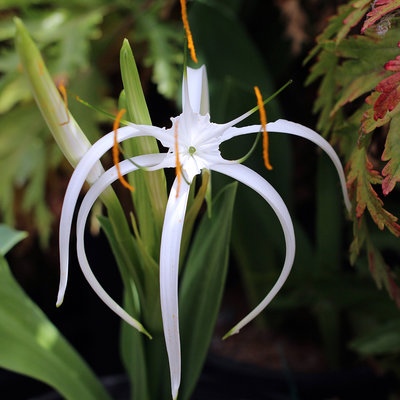
Spider Lily (Hymenocallis harrisiana)
This easy-to-grow bulb makes a great border plant and is even drought-tolerant once established. Its long, elegant petals bloom in summer and grow up to 15 inches tall. While attractive, these fragrant flowers don’t live very long on the plant itself, but last for quite a while as cut flowers.
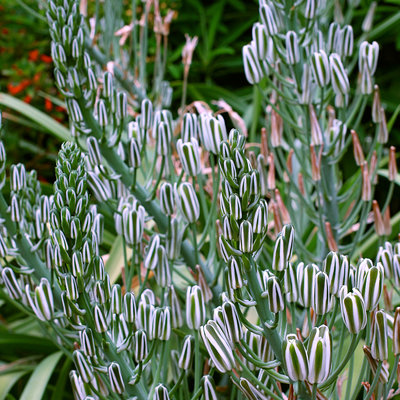
Albuca batteniana
An incredibly unique plant, this South African bulb boasts thickly striped buds, which open up to white starry flowers come spring. A good choice for water-wise gardens, this plant requires low to no water in summer with average irrigating during spring.
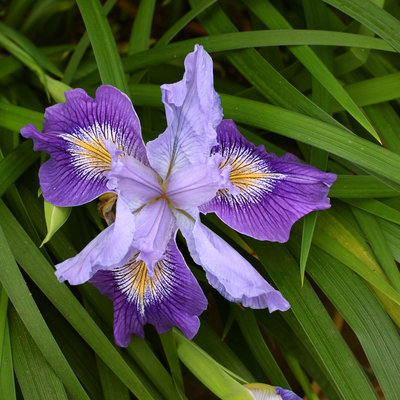
Royal Peacock (Iris douglasiana ‘Royal Peacock’)
Much like the male peacock, this gorgeous plant blooms with bold patterns and bright colors. It also produces rather large flowers, widening up to four to five inches. Native to California, these low-maintenance Pacific Coast irises can take shade and drought conditions, and are even deer-friendly.
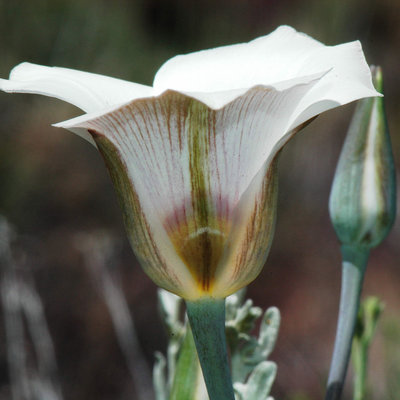
Bruneau Mariposa lily (Calochortus bruneaunis)
Originally from the Great Basin, this wild lily is notably low-water as it emerged from a region known for harsh desert conditions, cold winters, and hot summers. It’s commonly grown in Idaho, Montana, Oregon, Nevada, and eastern California in high desert scrub, pine, and juniper woodlands.
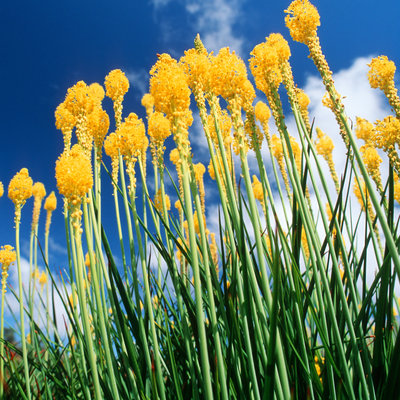
Yellow Cat’s Tail (Bulbinella latifolia)
Tall, striking, and colorful, this South African bulb soaks up winter rains, blooms in spring, and goes dormant in summer when it needs little to no water. Fitting for both dry gardens and containers, these yellow beauties look lovely when grouped together or shown off as cut flowers.
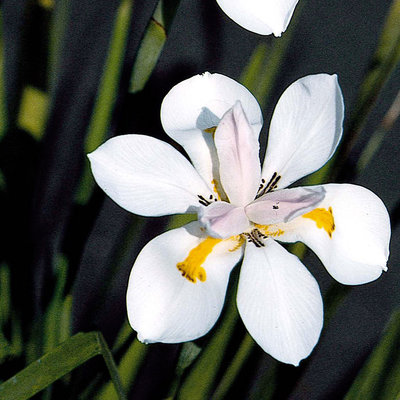
African Iris (Dietes iridioides)
These exotic white flowers bear yellow and purple-blue bursts and bloom profusely. Once established they only need occasional watering and will bloom from spring to late fall. Rather flexible, these fire-resistant irises are fitting in rock gardens, woodland spaces, containers, and more.
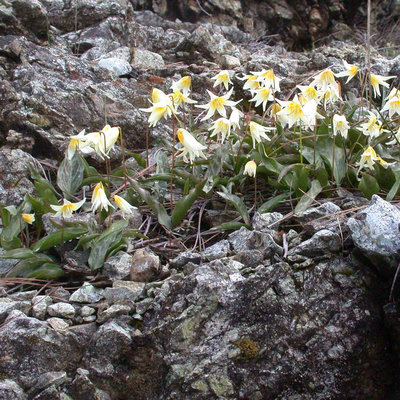
Sierra Fawnlily (Erythronium multiscapoideum)
A lover of shaded, tree-covered areas, this bulb-producing perennial hosts creamy white flowers with yellow undersides. An early-spring Northern-California bloomer, the fawnlily prefers rich and well-drained soils and goes dormant in spring, minimizing watering during hot summer months.
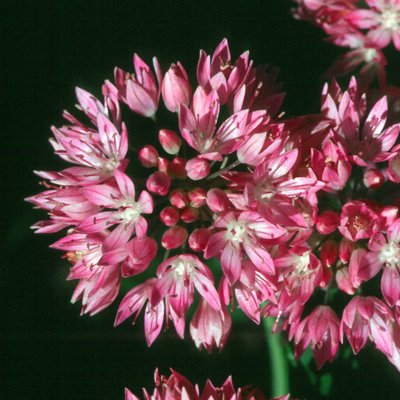
Narrow Leaf onion (Allium amplectens)
A beloved gem of Oregon and California, this bright pink plant opens into clusters of firework-like flowers. Known to prefer dry, clay soils and full sun conditions, this wild onion can be found at Telos Rare Bulbs, but is difficult to source outside of that nursery.
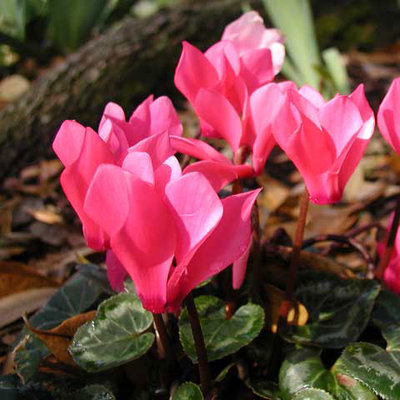
Cyclamen (Cyclamen persicum)
Growing just under twelve inches tall, these container-friendly flowers come in red, pink, violet, lavender, and white. Native to Mediterranean climates, cyclamen bring heart-shaped leaves to the garden in spring and go dormant in summer.
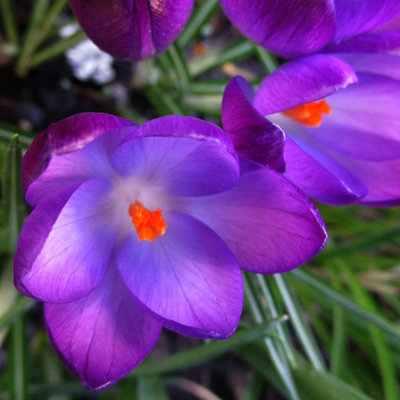
Saffron crocus (Crocus sativus)
These fall-blooming corms yield purple petals. Their bright red stigmas produce the common culinary herb, saffron. Due to each flower’s miniscule offering, it’s hard to grow industrial amounts. Nevertheless, they make great low-water options due to their attractive color and summer dormancy.

Photo courtesy of Annies Annuals & Perennials
Spider Lily (Hymenocallis harrisiana)
This easy-to-grow bulb makes a great border plant and is even drought-tolerant once established. Its long, elegant petals bloom in summer and grow up to 15 inches tall. While attractive, these fragrant flowers don’t live very long on the plant itself, but last for quite a while as cut flowers.

Photo courtesy of Annie’s Annuals and Perennials
Albuca batteniana
An incredibly unique plant, this South African bulb boasts thickly striped buds, which open up to white starry flowers come spring. A good choice for water-wise gardens, this plant requires low to no water in summer with average irrigating during spring.

Photo courtesy of Annie’s Annuals and Perennials
Royal Peacock (Iris douglasiana ‘Royal Peacock’)
Much like the male peacock, this gorgeous plant blooms with bold patterns and bright colors. It also produces rather large flowers, widening up to four to five inches. Native to California, these low-maintenance Pacific Coast irises can take shade and drought conditions, and are even deer-friendly.

Photo courtesy of Gary A. Monroe
Bruneau Mariposa lily (Calochortus bruneaunis)
Originally from the Great Basin, this wild lily is notably low-water as it emerged from a region known for harsh desert conditions, cold winters, and hot summers. It’s commonly grown in Idaho, Montana, Oregon, Nevada, and eastern California in high desert scrub, pine, and juniper woodlands.

Lanz von Horsten / Getty Images
Yellow Cat’s Tail (Bulbinella latifolia)
Tall, striking, and colorful, this South African bulb soaks up winter rains, blooms in spring, and goes dormant in summer when it needs little to no water. Fitting for both dry gardens and containers, these yellow beauties look lovely when grouped together or shown off as cut flowers.

Photo courtesy of Monrovia
African Iris (Dietes iridioides)
These exotic white flowers bear yellow and purple-blue bursts and bloom profusely. Once established they only need occasional watering and will bloom from spring to late fall. Rather flexible, these fire-resistant irises are fitting in rock gardens, woodland spaces, containers, and more.

Photo courtesy of Gary A. Monroe
Sierra Fawnlily (Erythronium multiscapoideum)
A lover of shaded, tree-covered areas, this bulb-producing perennial hosts creamy white flowers with yellow undersides. An early-spring Northern-California bloomer, the fawnlily prefers rich and well-drained soils and goes dormant in spring, minimizing watering during hot summer months.

Creative Commons photo by Bureau of Land Management of Oregon and Washington is licensed under CC BY 2.0
Narrow Leaf onion (Allium amplectens)
A beloved gem of Oregon and California, this bright pink plant opens into clusters of firework-like flowers. Known to prefer dry, clay soils and full sun conditions, this wild onion can be found at Telos Rare Bulbs, but is difficult to source outside of that nursery.

Creative Commons photo by Bill Murray is licensed under CC BY 2.0
Cyclamen (Cyclamen persicum)
Growing just under twelve inches tall, these container-friendly flowers come in red, pink, violet, lavender, and white. Native to Mediterranean climates, cyclamen bring heart-shaped leaves to the garden in spring and go dormant in summer.

Creative Commons photo by Julie Anne Johnson is licensed under CC BY 2.0
Saffron crocus (Crocus sativus)
These fall-blooming corms yield purple petals. Their bright red stigmas produce the common culinary herb, saffron. Due to each flower’s miniscule offering, it’s hard to grow industrial amounts. Nevertheless, they make great low-water options due to their attractive color and summer dormancy.
Around The Web
Related Links
Plant these drought-friendly flowers for lasting color with low environmental impact

Spider Lily (Hymenocallis harrisiana)
This easy-to-grow bulb makes a great border plant and is even drought-tolerant once established. Its long, elegant petals bloom in summer and grow up to 15 inches tall. While attractive, these fragrant flowers don’t live very long on the plant itself, but last for quite a while as cut flowers.

Albuca batteniana
An incredibly unique plant, this South African bulb boasts thickly striped buds, which open up to white starry flowers come spring. A good choice for water-wise gardens, this plant requires low to no water in summer with average irrigating during spring.

Royal Peacock (Iris douglasiana ‘Royal Peacock’)
Much like the male peacock, this gorgeous plant blooms with bold patterns and bright colors. It also produces rather large flowers, widening up to four to five inches. Native to California, these low-maintenance Pacific Coast irises can take shade and drought conditions, and are even deer-friendly.

Bruneau Mariposa lily (Calochortus bruneaunis)
Originally from the Great Basin, this wild lily is notably low-water as it emerged from a region known for harsh desert conditions, cold winters, and hot summers. It’s commonly grown in Idaho, Montana, Oregon, Nevada, and eastern California in high desert scrub, pine, and juniper woodlands.

Yellow Cat’s Tail (Bulbinella latifolia)
Tall, striking, and colorful, this South African bulb soaks up winter rains, blooms in spring, and goes dormant in summer when it needs little to no water. Fitting for both dry gardens and containers, these yellow beauties look lovely when grouped together or shown off as cut flowers.

African Iris (Dietes iridioides)
These exotic white flowers bear yellow and purple-blue bursts and bloom profusely. Once established they only need occasional watering and will bloom from spring to late fall. Rather flexible, these fire-resistant irises are fitting in rock gardens, woodland spaces, containers, and more.

Sierra Fawnlily (Erythronium multiscapoideum)
A lover of shaded, tree-covered areas, this bulb-producing perennial hosts creamy white flowers with yellow undersides. An early-spring Northern-California bloomer, the fawnlily prefers rich and well-drained soils and goes dormant in spring, minimizing watering during hot summer months.

Narrow Leaf onion (Allium amplectens)
A beloved gem of Oregon and California, this bright pink plant opens into clusters of firework-like flowers. Known to prefer dry, clay soils and full sun conditions, this wild onion can be found at Telos Rare Bulbs, but is difficult to source outside of that nursery.

Cyclamen (Cyclamen persicum)
Growing just under twelve inches tall, these container-friendly flowers come in red, pink, violet, lavender, and white. Native to Mediterranean climates, cyclamen bring heart-shaped leaves to the garden in spring and go dormant in summer.

Saffron crocus (Crocus sativus)
These fall-blooming corms yield purple petals. Their bright red stigmas produce the common culinary herb, saffron. Due to each flower’s miniscule offering, it’s hard to grow industrial amounts. Nevertheless, they make great low-water options due to their attractive color and summer dormancy.

Photo courtesy of Annies Annuals & Perennials
Spider Lily (Hymenocallis harrisiana)
This easy-to-grow bulb makes a great border plant and is even drought-tolerant once established. Its long, elegant petals bloom in summer and grow up to 15 inches tall. While attractive, these fragrant flowers don’t live very long on the plant itself, but last for quite a while as cut flowers.

Photo courtesy of Annie’s Annuals and Perennials
Albuca batteniana
An incredibly unique plant, this South African bulb boasts thickly striped buds, which open up to white starry flowers come spring. A good choice for water-wise gardens, this plant requires low to no water in summer with average irrigating during spring.

Photo courtesy of Annie’s Annuals and Perennials
Royal Peacock (Iris douglasiana ‘Royal Peacock’)
Much like the male peacock, this gorgeous plant blooms with bold patterns and bright colors. It also produces rather large flowers, widening up to four to five inches. Native to California, these low-maintenance Pacific Coast irises can take shade and drought conditions, and are even deer-friendly.

Photo courtesy of Gary A. Monroe
Bruneau Mariposa lily (Calochortus bruneaunis)
Originally from the Great Basin, this wild lily is notably low-water as it emerged from a region known for harsh desert conditions, cold winters, and hot summers. It’s commonly grown in Idaho, Montana, Oregon, Nevada, and eastern California in high desert scrub, pine, and juniper woodlands.

Lanz von Horsten / Getty Images
Yellow Cat’s Tail (Bulbinella latifolia)
Tall, striking, and colorful, this South African bulb soaks up winter rains, blooms in spring, and goes dormant in summer when it needs little to no water. Fitting for both dry gardens and containers, these yellow beauties look lovely when grouped together or shown off as cut flowers.

Photo courtesy of Monrovia
African Iris (Dietes iridioides)
These exotic white flowers bear yellow and purple-blue bursts and bloom profusely. Once established they only need occasional watering and will bloom from spring to late fall. Rather flexible, these fire-resistant irises are fitting in rock gardens, woodland spaces, containers, and more.

Photo courtesy of Gary A. Monroe
Sierra Fawnlily (Erythronium multiscapoideum)
A lover of shaded, tree-covered areas, this bulb-producing perennial hosts creamy white flowers with yellow undersides. An early-spring Northern-California bloomer, the fawnlily prefers rich and well-drained soils and goes dormant in spring, minimizing watering during hot summer months.

Creative Commons photo by Bureau of Land Management of Oregon and Washington is licensed under CC BY 2.0
Narrow Leaf onion (Allium amplectens)
A beloved gem of Oregon and California, this bright pink plant opens into clusters of firework-like flowers. Known to prefer dry, clay soils and full sun conditions, this wild onion can be found at Telos Rare Bulbs, but is difficult to source outside of that nursery.

Creative Commons photo by Bill Murray is licensed under CC BY 2.0
Cyclamen (Cyclamen persicum)
Growing just under twelve inches tall, these container-friendly flowers come in red, pink, violet, lavender, and white. Native to Mediterranean climates, cyclamen bring heart-shaped leaves to the garden in spring and go dormant in summer.

Creative Commons photo by Julie Anne Johnson is licensed under CC BY 2.0
Saffron crocus (Crocus sativus)
These fall-blooming corms yield purple petals. Their bright red stigmas produce the common culinary herb, saffron. Due to each flower’s miniscule offering, it’s hard to grow industrial amounts. Nevertheless, they make great low-water options due to their attractive color and summer dormancy.
Around The Web
Related Links